Moroccan Public Buildings and the RTCM: Insights into Compliance, Energy Performance, and Regulation Improvement
Abstract
1. Introduction
2. Literature Review
2.1. Policy Implications for Enhancing Energy Efficiency
2.2. Building Energy Efficiency in Morocco
2.3. Novelty and Research Contribution
3. Materials and Methods
3.1. Data of the Conventional Public Building
3.2. Dynamic Thermal Simulations
3.3. Building Description
3.4. Building Materials
3.4.1. Exterior Walls
- An exterior coating of cement and sand mortar;
- 8-hole ceramic exterior bricks (10 cm thick);
- Air gap;
- Interior bricks with 6 holes (7 cm thick);
- An interior coating of cement and sand mortar.
3.4.2. Roofs and Intermediate Floors
- Generally, the solution of the floor with beams is more present than the solution of the solid slab for the floor–roof and the intermediate floors; the most used beams are in pre-stressed concrete, prefabricated in the factory. The roof structure consists of beams and hollow blocks, a sloping form, a leveling screed (smoothed cement), a waterproofing system, and mechanical protection (concrete scuppers of 4 cm or red cement tiles). A 4 cm polystyrene or rock wool insulation was provided on the roof floor in some cases.
3.4.3. Floor on Ground
- Generally, the ground floor is composed as follows:
- Tile of 2 cm;
- Sand bed of 4 cm;
- The concrete slab of 13 cm;
- Hedgehog 15 to 20 cm or 20 cm of all-round soil.
3.5. Choice of Insulation
4. Results
4.1. Conformity Assessment and Energy Impact of A-Pres Compliance
4.2. Impact of Retrofitting Each Envelope Element on Energy Consumption for 3 TGBV Cases
4.3. Comparison between Zones
- Errachidia, the desert Zone 6, has the highest energy intensity, followed by Marrakech (semi-arid Zone 5), Fez (continental Zone 3), Ifrane (cold Zone 4), Tangier (Mediterranean Zone 2), and Agadir (Atlantic Zone 1). This trend could be attributed to the more extreme weather conditions experienced in Zone 6, resulting in higher energy demand for indoor climate control.
- The impact of roof insulation varies across zones. In Agadir (Zone 1), it results in adverse effects, likely due to the mild Atlantic climate where increased insulation could trap undesired solar heat. The benefit of roof insulation gradually increases, moving towards colder climates and becoming highly beneficial in Ifrane (Zone 4). However, its effectiveness tapers off slightly in Zones 5 and 6, which experience more extreme temperatures.
- Wall insulation, though negligible in Zones 1, 2, and 3, offers slight improvements in the colder and more extreme Zones 4, 5, and 6. It indicates how insulation effectiveness is tied to the region’s climatic conditions.
- Roof insulation takes precedence over wall insulation in the colder zones of Fez and Ifrane (Zones 3 and 4) due to the phenomena of thermal buoyancy aiding in the retention of internal heat. This dynamic changes in the desert zone of Errachidia (Zone 6), where summer losses counteract winter gains through insulation.
- Ground floor insulation consistently escalates thermal Building Energy Consumption (BECth) across all zones, implying a misalignment of RTCM A-Pres requirements with climatic realities, necessitating further exploration.
- Glazing compliance significantly enhances BECth, intensifying as the TGBV expands. This indicates the crucial role of adequately designed and installed glazing in regulating indoor temperature and light in all climates.
- These observations underscore the need for climate-specific guidelines in building design and retrofit strategies to optimize energy efficiency, demonstrating the local climate’s substantial role in shaping a building’s energy footprint.
4.4. Comparison with a Colder Climate
5. Discussion
5.1. Comparison of Our Results with the Literature
5.2. Comparison of Our Results with the RTCM Predictions
5.3. Comparison between the Two RTCM Approaches
5.4. Energy Efficiency Improvements in the RTCM
- Provide advanced glazing, compact fluorescent lamps (CFL), efficient air conditioning systems, efficient lighting installations, a minimum solar contribution for domestic hot water, and a minimum photovoltaic contribution for electrical energy;
- Study the orientation and compactness of the building in advance;
- Consider the architectural design, the suitability of building materials with a climate system adapted to the local climate, passive cooling;
- Limit the TGBV per area;
- Revise insulation requirements, adding it where it is beneficial (roof for Zone 4) and removing it from areas where its negative impact has been demonstrated (ground floor for all zones, roof for Zone 1);
- Add requirements for the thickness of the air space, considered as a free insulator, and integrate requirements on the thermal inertia of materials;
- Provide ventilation and infiltration control (require maximum infiltration rate in cold areas, and add natural ventilation requirements in warm areas);
- Provide exterior wall and roof color requirements;
- Integrate energy management techniques;
- Review the comfort zones according to the thermal zones;
- Extend the RTCM to existing buildings.
- 12.
- Provide a study on incremental costs by differentiating between the two approaches;
- 13.
- Improve the thermal simulation software, and make available conventional elements and materials;
- 14.
- Produce a detailed guide covering the normative and regulatory devices to be taken into account in the study and design phases of buildings responding to the RTCM;
- 15.
- Develop mechanisms for monitoring and verifying the application of the RTCM in contracts and on sites (auditor training, verification equipment, procedures);
- 16.
- Develop state subsidy mechanisms;
- 17.
- Develop communication around the RTCM, as well as training and awareness on EE.
6. Conclusions
Author Contributions
Funding
Data Availability Statement
Acknowledgments
Conflicts of Interest
Nomenclature
| A-Pres | Prescriptive approach |
| A-Perf | Performance approach |
| BPs | Public Buildings |
| BECth | Annual energy demand for thermal comfort (kWh/m2/year) |
| BECh | Annual heating energy demand (kWh/year) |
| BERef | Annual cooling energy demand (kWh/year) |
| EE | Energy Efficiency |
| Fs | Solar factor |
| Fs* | Solar equivalent factor |
| RTCM | Thermal regulation of constructions in Morocco |
| TGBV | Overall rate of glass bays |
References
- IEA. International Energy Agency Publishes New Review of Morocco’s Energy Policies-News-IEA. News 2019. Available online: https://www.iea.org/news/international-energy-agency-publishes-new-review-of-moroccos-energy-policies (accessed on 12 October 2022).
- Jamil, M.N. Critical analysis of energy consumption and its impact on countries economic growth: An empirical analysis base on countries income level. J. Environ. Sci. Econ. 2022, 1, 1–12. [Google Scholar] [CrossRef]
- Abdou, N.; Mghouchi, Y.; Hamdaoui, S.; Asri, N.; Mouqallid, M. Multi-objective optimization of passive energy efficiency measures for net-zero energy building in Morocco. Build. Environ. 2021, 204, 1–16. [Google Scholar] [CrossRef]
- Ozoadibe, C.J.; Obi, H.E. Exploring Renewable Energy Facility and Green Building Practices for Improved Archives Preservation in Public Libraries in Rivers State. J. Environ. Sci. Econ. 2023, 2, 45–54. [Google Scholar] [CrossRef]
- Aljawabra, F.; Nikolopoulou, M. Thermal comfort in urban spaces: A cross-cultural study in the hot arid climate. Int. J. Biometeorology. 2018, 62, 1901–1909. [Google Scholar]
- Zhao, J.; Xin, Y.; Tong, D. Energy consumption quota of public buildings based on statistical analysis. Energy Policy 2012, 43, 362–370. [Google Scholar] [CrossRef]
- El Asri, N.; Nouira, Y.; Maaroufi, I.; Marfak, A.; Saleh, N.; Mharzi, M. The Policy of Energy Management in Public Buildings Procurements through the Study of the Process of Delegated Project Management-Case of Morocco. Energy Policy 2022, 165, 112944. [Google Scholar] [CrossRef]
- Sick, F.; Schade, S.; Mourtada, A.; Uh, D.; Grausam, M. Dynamic building simulations for the establishment of a Moroccan thermal regulation for buildings. J. Green Build. 2020, 9, 145–165. [Google Scholar] [CrossRef]
- AMEE “Agence Marocaine de l’Efficacité Énergétique”. Available online: https://www.amee.ma/ (accessed on 20 October 2022).
- Haddadi, T.; Mourabit, T.; Haddadi, A. Évaluation de la Durabilité Dans les Marchés Publics Marocains. Centre Natl. Doc. 2017, 1–9. Available online: https://atlas.irit.fr/PIE/VSST/Actes-VSST2018-Toulouse/Mourabit.pdf (accessed on 22 September 2022).
- Modi, S.; Isyaku, I.S.; Kogi, T.M.; Danladi, A.; Sambo, B.P.; Gado, E.A. Orientation as a Panacea for Improving the Thermal Performance of a Fully Enclosed Courtyard in a Typical Tropical Climate. J. Environ. Sci. Econ. 2022, 1, 51–59. [Google Scholar] [CrossRef]
- Lopez, F.; Santiago, M. Sensitivity Study of an Opaque Ventilated Façade in the Winter Season in Different Climate Zones in Spain. Renew. Energy 2015, 75, 524–533. [Google Scholar]
- D’Agostino, D.; Cuniberti, B.; Bertoldi, P. Energy Consumption and Efficiency Technology Measures in European Non-Residential Buildings. Energy Build. 2017, 153, 72–86. [Google Scholar]
- Dongmei, S. Research and Application of Energy Consumption Benchmarking: Method for Public Buildings Based on Actual Energy Consumption. Energy Proc. 2018, 152, 475–483. [Google Scholar] [CrossRef]
- Economidou, M.; Todeschi, V.; Bertoldi, P.; D’Agostino, D.; Zangheri, P.; Castellazzi, L. Review of Half a Century of EU Energy Efficiency Policies for Buildings. Energy Build. 2020, 225, 110322. [Google Scholar] [CrossRef]
- Salvalai, G.; Masera, G.; Sesana, M. Italian Local Codes for Energy Efficiency of Buildings: Theoretical Definition and Experimental Application to a Residential Case Study. Renew. Sustain. Energy Rev. 2015, 42, 1245–1259. [Google Scholar] [CrossRef]
- Alam, M.; Zou, P.X.; Stewart, R.A.; Bertone, E.; Sahin, O.; Buntine, C.; Marshall, C. Government Championed Strategies to Overcome the Barriers to Public Building Energy Efficiency Retrofit Projects. Sustain. Cities Soc. 2019, 44, 56–69. [Google Scholar] [CrossRef]
- Tolón-Becerra, A.; Lastra-Bravo, X.B.; Fernández-Membrive, V.J.; Flores-Parra, I. Opportunities in Spanish Energy Efficiency: Current Situation, Trends, and Potential in the Building Sector. Energy Proced. 2013, 42, 63–72. [Google Scholar]
- Hamza, N.; Greenwood, D. Impacts of Energy Conservation Regulations on Design and Procurement of Low Energy Buildings. Build. Environ. 2009, 44, 929–936. [Google Scholar] [CrossRef]
- Merini, I.; Molina-García, A.; García-Cascales, M.S.; Mahdaoui, M.; Ahachad, M. Analysis and comparison of energy efficiency code requirements for buildings: A Morocco–Spain case study. Energies 2020, 13, 5979. [Google Scholar] [CrossRef]
- Mastouri, H.; Bahi, H.; Radoine, H.; Benhamou, B. Thermal performance and adherence of local materials to the Moroccan Building Code requirements. In Proceedings of the 5th International Conference on Renewable Energies for Developing Countries, Marrakech, Morocco, 29–30 June 2020; Volume 5, pp. 14–18. [Google Scholar]
- El Kadiri, S.E.; Kaitouni, S.I.; Ikken, B.; Otmani, R.E. Thermal performance of a residential building in Ben Guerir city: A comparative evaluation for an optimized thermal load needs. In Proceedings of the 2018 6th International Renewable and Sustainable Energy Conference (IRSEC), Rabat, Morocco, 5–8 December 2018. [Google Scholar] [CrossRef]
- Lafqir, F.E.; Sobhy, I.; Benhamou, B.; Bennouna, A.; Limam, K. Thermal performance of passive techniques integrated to a house and the concept of passive house in the six climates of Morocco. Sci. Technol. Built Environ. 2020, 26, 1490–1508. [Google Scholar] [CrossRef]
- Hashemi, A. Effects of thermal insulation on thermal comfort in low-income tropical housing. Energy Procedia 2017, 134, 815–824. [Google Scholar] [CrossRef]
- Lebied, M.; Sick, F.; Choulli, Z.; El Bouardi, A. Improving the passive building energy efficiency through numerical simulation–A case study for Tetouan climate in northern of Morocco. Case Stud. Therm. Eng. 2018, 11, 125–134. [Google Scholar] [CrossRef]
- Sobhy, I.; Brakez, A.; Benhamou, B. Thermal Comfort Analysis of a House Retrofitted According to the Moroccan Building Energy Code. In Proceedings of the 2016 International Renewable and Sustainable Energy Conference (IRSEC), Marrakech, Morocco, 14–17 November 2016; pp. 849–854. [Google Scholar]
- Lamrani, A.; Safar, S.; Rougui, M. Parametric study of the thermal performance of a typical administrative building in the six thermal zones according to the RTCM, using TRNSYS. MATEC Web Conf. 2018, 149, 02097. [Google Scholar] [CrossRef][Green Version]
- Saidur, R. Energy consumption, energy savings, and emission analysis in Malaysian office buildings. Energy Policy 2009, 37, 4104–4113. [Google Scholar] [CrossRef]
- Mathews, E.H.; Van Wyk, S.L. Energy efficiency of formal low-cost housing in South Africa’s Gauteng region. Energy Build. 1996, 24, 117–123. [Google Scholar] [CrossRef]
- El Harrouni, K.; Filali, M.; Kharmich, H.; Mansour, M.; Laaroussi, N.; Garoum, M. Energy efficient houses meeting both bioclimatic architecture principles and Moroccan thermal regulation. In Proceedings of the 2018 6th International Renewable and Sustainable Energy Conference (IRSEC), Rabat, Morocco, 21–23 November 2018; pp. 1–8. [Google Scholar] [CrossRef]
- Dlimi, M.; Iken, O.; Agounoun, R.; Zoubir, A.; Kadiri, I.; Sbai, K. Energy Performance and Thickness Optimization of Hemp Wool Insulation and Air Cavity Layers Integrated in Moroccan Building Walls. Sustain. Prod. Consum. 2019, 20, 273–288. [Google Scholar] [CrossRef]
- Echlouchi, K.; Ouardouz, M.; Bernoussi, A.S. Eco-District, an Ideal Framework to Initiate Large-Scale Urban Energy Renovation in Morocco. J. Ecol. Eng. 2022, 23, 100–114. [Google Scholar] [CrossRef]
- M’lahfi, B.; Amegouz, D.; El Qandil, M. A New Approach for the Mandatory Application of the Thermal Regulation of Construction (RTCM) in the Future Moroccan Buildings. SN Appl. Sci. 2020, 2, 10. [Google Scholar] [CrossRef]
- Abdou, N.; El Mghouchi, Y.; Jraida, K.; Hamdaoui, S.; Hajou, A.; Mouqallid, M. Prediction and Optimization of Heating and Cooling Loads for Low Energy Buildings in Morocco: An Application of Hybrid Machine Learning Methods. J. Build. Eng. 2022, 61, 105332. [Google Scholar] [CrossRef]
- Abdou, N.; El Mghouchi, Y.; Hamdaoui, S.; Mhamed, M. Optimal Building Envelope Design and Renewable Energy Systems Size for Net-Zero Energy Building in Tetouan, Morocco. In Proceedings of the 2021 9th International Renewable and Sustainable Energy Conference (IRSEC), Tetouan, Morocco, 23–27 November 2021; pp. 1–6. [Google Scholar] [CrossRef]
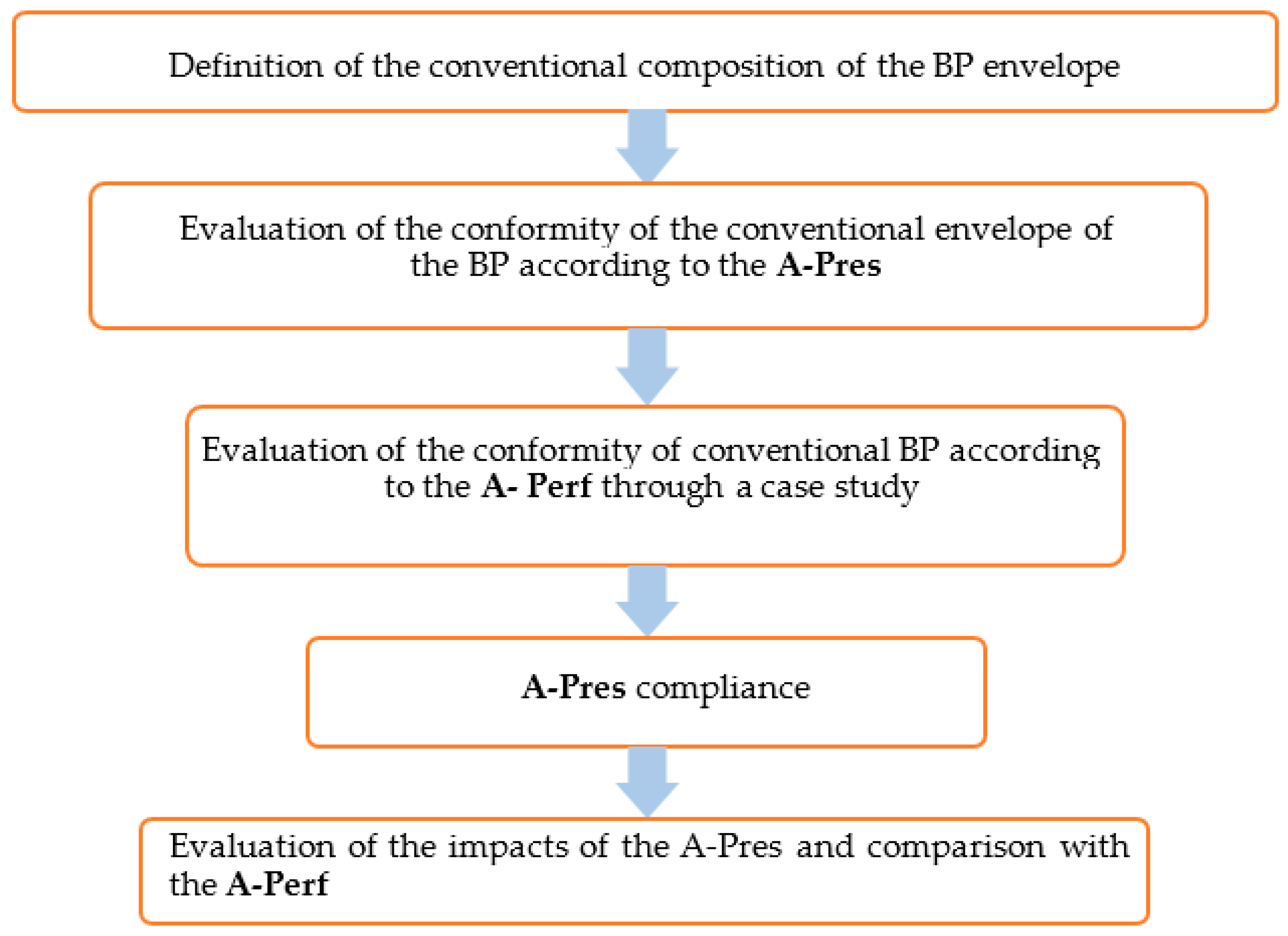
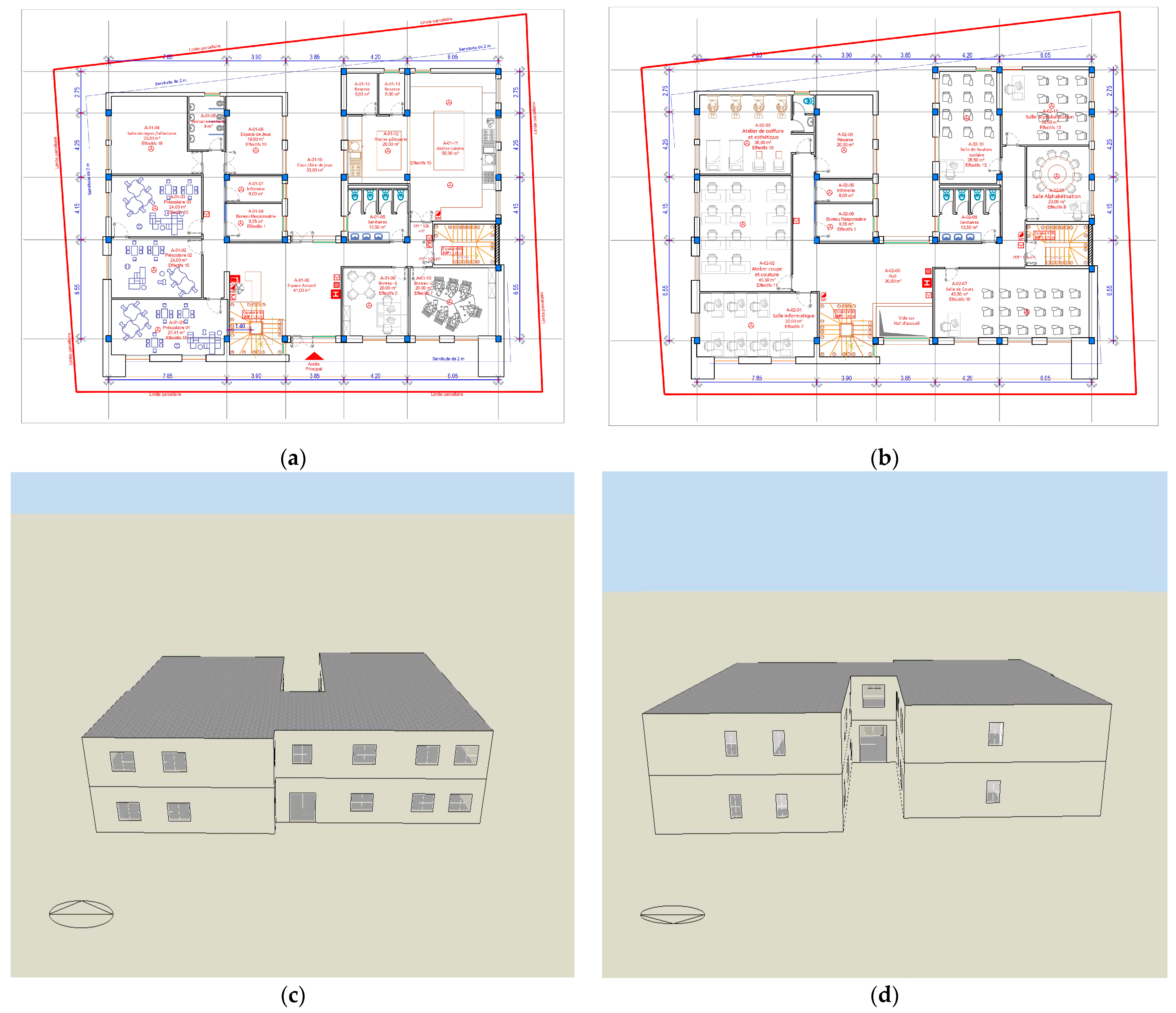
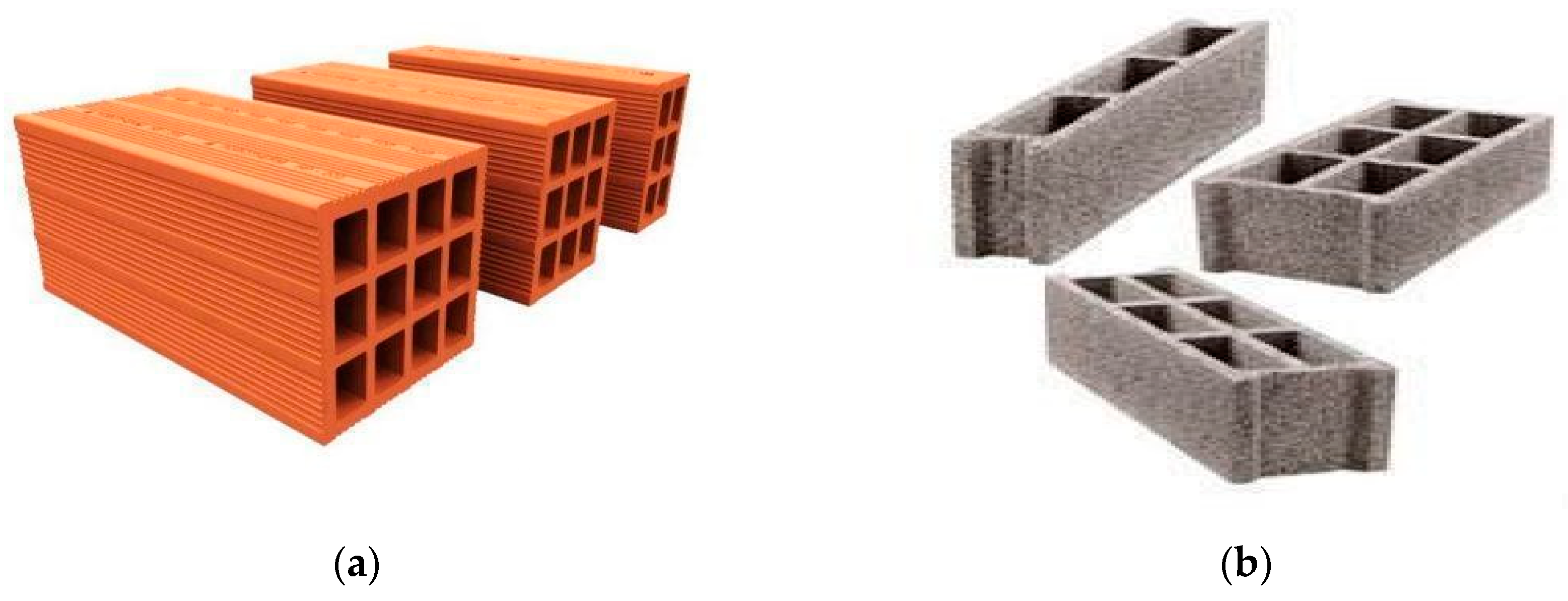

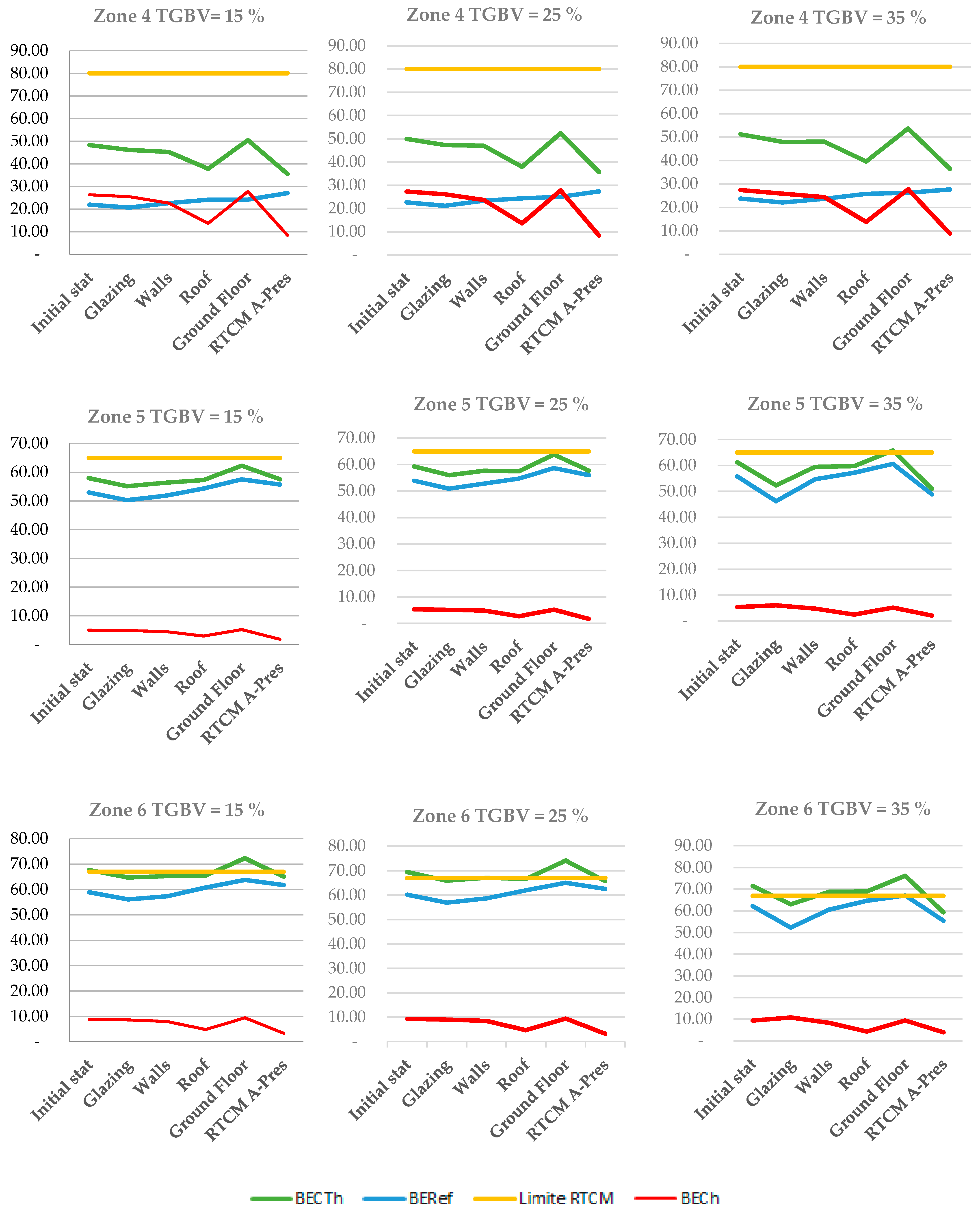
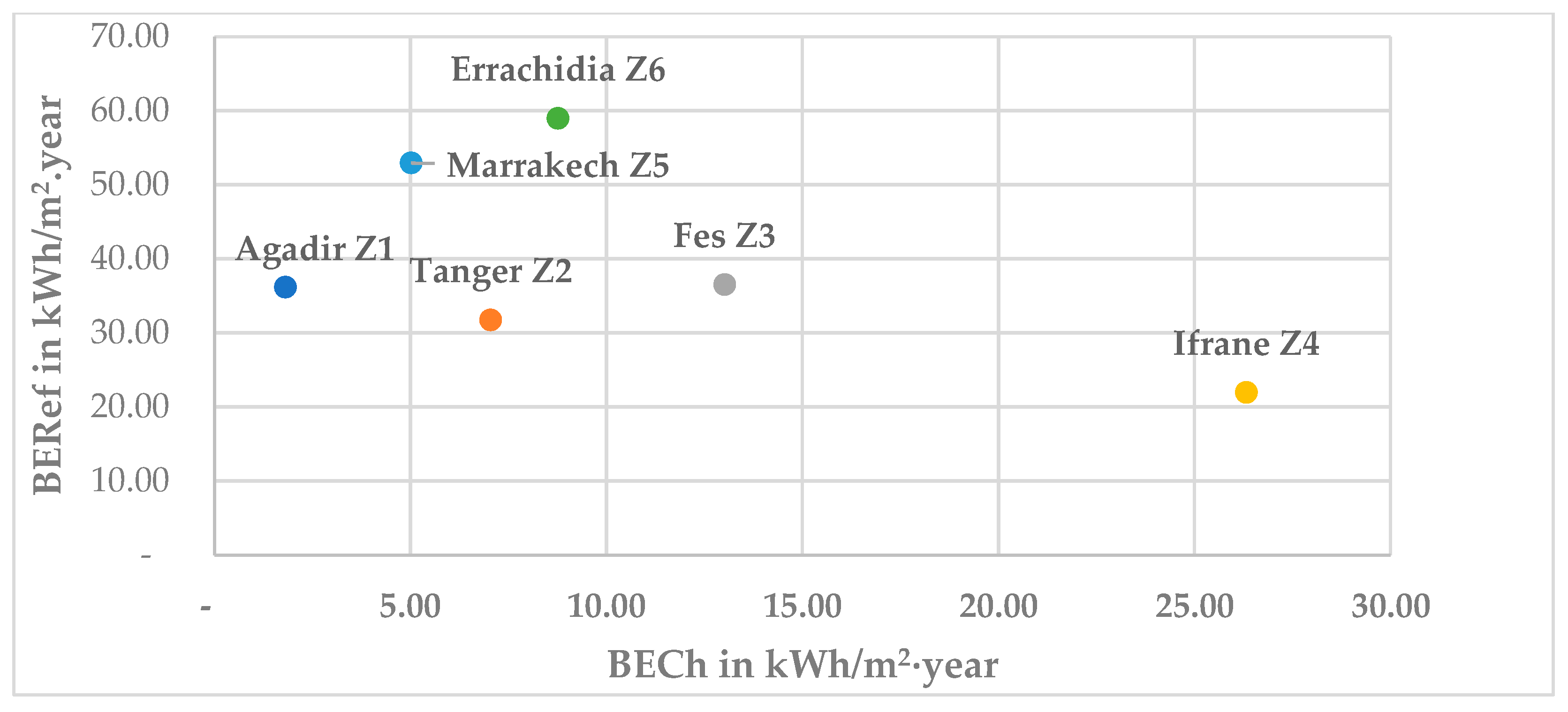


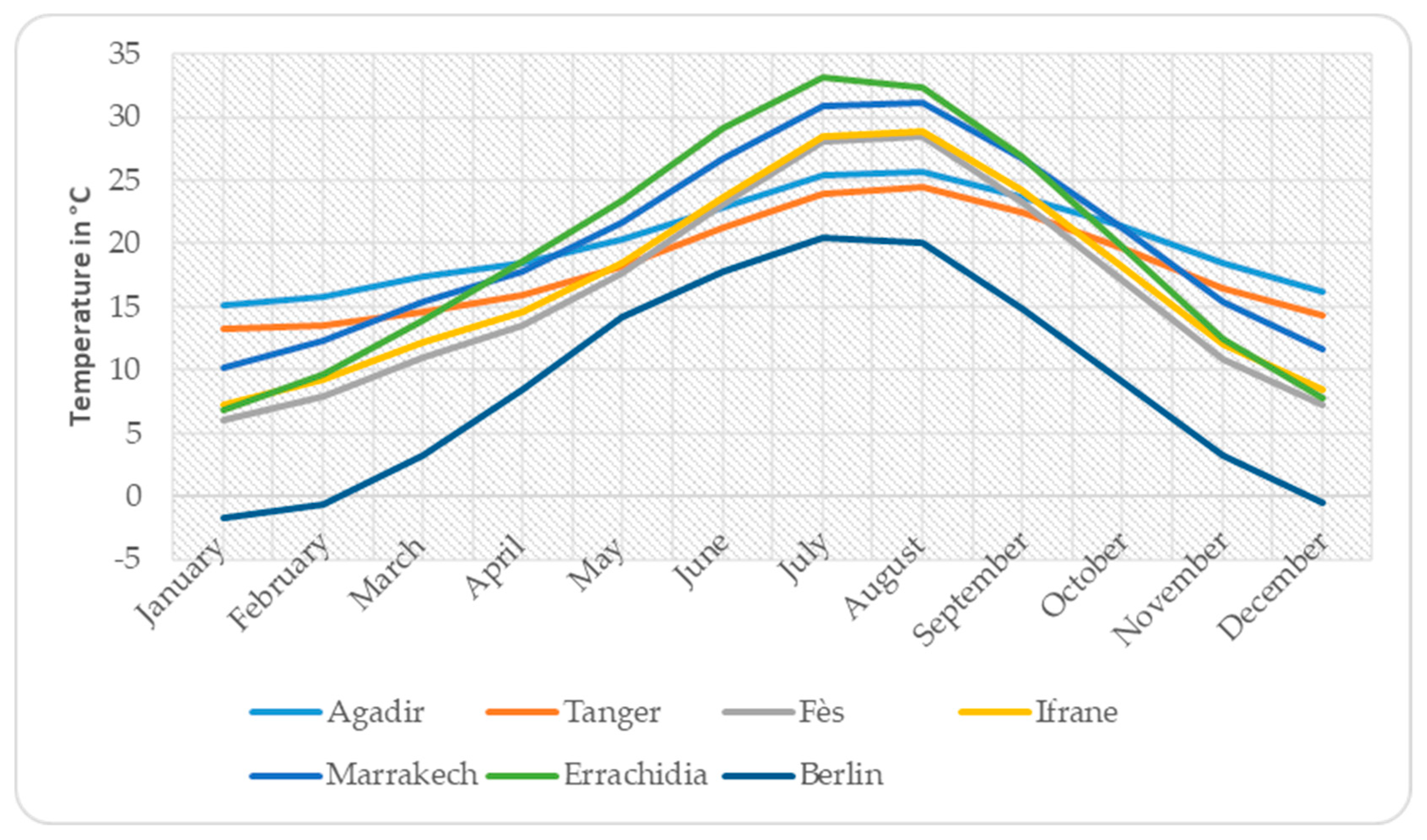
| Location (Zone) | Schools | Administrations | Hospitals | Hotels |
|---|---|---|---|---|
| Agadir (Z1) | 44 | 45 | 72 | 48 |
| Tangier (Z2) | 50 | 49 | 73 | 52 |
| Fez (Z3) | 61 | 49 | 68 | 66 |
| Ifrane (Z4) | 80 | 35 | 47 | 34 |
| Marrakech (Z5) | 65 | 56 | 92 | 88 |
| Errachidia (Z6) | 67 | 58 | 93 | 88 |
| Walls | Extruded Polystyrene | Polyurethane (PUR) | Agglomerated Cork | |||
|---|---|---|---|---|---|---|
| Theoretical Thickness (cm) | Installed Thickness (cm) | Theoretical Thickness (cm) | Installed Thickness (cm) | Theoretical Thickness (cm) | Installed Thickness (cm) | |
| Flat roof | 3.68 | 4 | 2.71 | 4 | 4.12 | 6 |
| Exterior walls | 0.50 | 2 | 0.36 | 2 | 0.56 | 2 |
| Floors on the ground | NE * | NE | NE | NE | NE | NE |
| Insulation price (DH/m2) | 79.7 DH for 2 cm for walls and 88.79 DH for 4 cm for the roof | 141.62 DH for 2 cm for walls and 169.12 DH for 4 cm for the roof | 180.4 DH for 2 cm for walls and 502.37 DH for 6 cm for the roof | |||
| Type of Glazing | Single Glazing | Double Glazing (Cat 1) | Double Glazing (Cat 2) | Double Glazing (Cat 3) |
|---|---|---|---|---|
| Solar factor | 0.69 | 0.47 | 0.60 | 0.35 |
| U (W/m2·K) | 5.6 | 2.6 | 2.6 | 2.6 |
| Price (DH) | 200–283 | 400–800 | 1040 | 1040 |
| Cases for A-Pres compliance | Initial case | TGBV = 15%. | TGBV = 25%. | TGBV = 35%. |
| Zone | TGBV | U of Roofs (W/m2K) | U of the Walls (W/m2K) | U of the Glazing (W/m2K) | Minimum R of the Floor (m2K/W) | FS*, North | FS*, Other |
|---|---|---|---|---|---|---|---|
| Z1 | 15% 16–25% 26–35% 36–45% | NC 1 NC NC NC | C 2 C C C | C C NC NC | NE 3 NE NE NE | NE NE NE NC | NE NC NC NC |
| Z2 | 15% 16–25% 26–35% 36–45% | NC NC NC NC | NC NC NC NC | C NC NC NC | NE NE NE NE | NE NE NE NC | NE NC NC NC |
| Z3 | 15% 16–25% 26–35% 36–45% | NC NC NC NC | NC NC NC NC | NC NC NC NC | C C C C | NE NE NE NC | NE NC NC NC |
| Z4 | 15% 16–25% 26–35% 36–45% | NC NC NC NC | NC NC NC NC | NC NC NC NC | NC NC NC NC | NE NE NC NC | NE NC NC NC |
| Z5 | 15% 16–25% 26–35% 36–45% | NC NC NC NC | NC NC NC NC | NC NC NC NC | NC NC NC NC | NE NE NC NC | NE NC NC NC |
| Z6 | 15% 16–25% 26–35% 36–45% | NC NC NC NC | NC NC NC NC | NC NC NC NC | NC NC NC NC | NE NE NC NC | NE NC NC NC |
| Zone | Needs before the Application of A-Pres (kWh/ m2 /year) | Needs after the Application of A-Pres (kWh/m2/year) | RTCM Limit (Case: Schools) (kWh/ m2/Year) | Energy Gain in (KWh/m2/Year) | Percentage | ||||
|---|---|---|---|---|---|---|---|---|---|
| BECth | BERef | BECh | BECth | BERef | BECh | ||||
| 1 | 38.0 | 36.2 | 1.8 | 41.3 | 40.3 | 1.0 | 44.0 | −3.3 | −8.75% |
| 2 | 38.8 | 31.7 | 7.1 | 37.3 | 33.9 | 3.4 | 50.0 | 1.5 | 3.91% |
| 3 | 49.5 | 36.5 | 13.0 | 40.8 | 34.9 | 5.9 | 61.0 | 8.7 | 17.62% |
| 4 | 48.3 | 21.9 | 26.3 | 35.5 | 27.1 | 8.5 | 80.0 | 12.8 | 26.45% |
| 5 | 58.0 | 53.0 | 5.0 | 57.6 | 55.7 | 1.8 | 65.0 | 0.4 | 0.68% |
| 6 | 67.7 | 59.0 | 8.8 | 65.1 | 61.8 | 3.3 | 67.0 | 2.6 | 3.87% |
| Climate Zone | Initial A-Perf Compliance | A-Pres Compliance | Significant Requirement(s) |
|---|---|---|---|
| Zone 1 | Yes | Partial | Glazing |
| Zone 2 | Yes | Partial | Glazing |
| Zone 3 | Yes | Partial | Glazing, Roofing |
| Zone 4 | Yes | Partial | Roofing |
| Zone 5 | Yes | Partial | Glazing |
| Zone 6 | No | Partial | Glazing |
| Indicator | Our A-Pres Case Study * | Reference RTCM (School Establishment) * |
|---|---|---|
| The energy gain kWh/m2·year | Between −3.3 and 14.72 kWh/m2·year | 23 and 202 kWh/m2·year |
| Additional investment cost for compliance (*) | Between 1.28% (51.05 DH/m2) in zone 1 and 8.83% (353 DH/m2) in zone 4 | Between 1.93% (77 DH /m2) in zone 1 and 5.23% (209 DH /m2) in zone 4 |
Disclaimer/Publisher’s Note: The statements, opinions and data contained in all publications are solely those of the individual author(s) and contributor(s) and not of MDPI and/or the editor(s). MDPI and/or the editor(s) disclaim responsibility for any injury to people or property resulting from any ideas, methods, instructions or products referred to in the content. |
© 2023 by the authors. Licensee MDPI, Basel, Switzerland. This article is an open access article distributed under the terms and conditions of the Creative Commons Attribution (CC BY) license (https://creativecommons.org/licenses/by/4.0/).
Share and Cite
El Asri, N.; Abdou, N.; Mharzi, M.; Maghnouj, A. Moroccan Public Buildings and the RTCM: Insights into Compliance, Energy Performance, and Regulation Improvement. Energies 2023, 16, 6496. https://doi.org/10.3390/en16186496
El Asri N, Abdou N, Mharzi M, Maghnouj A. Moroccan Public Buildings and the RTCM: Insights into Compliance, Energy Performance, and Regulation Improvement. Energies. 2023; 16(18):6496. https://doi.org/10.3390/en16186496
Chicago/Turabian StyleEl Asri, Najat, Nawal Abdou, Mohammed Mharzi, and Abdelmajid Maghnouj. 2023. "Moroccan Public Buildings and the RTCM: Insights into Compliance, Energy Performance, and Regulation Improvement" Energies 16, no. 18: 6496. https://doi.org/10.3390/en16186496
APA StyleEl Asri, N., Abdou, N., Mharzi, M., & Maghnouj, A. (2023). Moroccan Public Buildings and the RTCM: Insights into Compliance, Energy Performance, and Regulation Improvement. Energies, 16(18), 6496. https://doi.org/10.3390/en16186496








